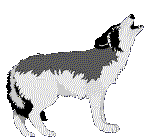Gray Wolf Links on the Internet: http://www.sinapu.org/ Extinction Notes Wolves: Fact or Fable Environmental Organizations Bibliography

“The howl of the wolf and coyote, which to some people is of more enduring significance than superhighways and skyscrapers, should always remain a part of our heritage.” --Ernest P. Walker, MAMMALS OF THE WORLD.
The gray wolf is the largest member of the dog family and has 27 subspecies. Beside humans, at one point it was the most populous mammal outside of the tropics. Except for humans, they are the most adaptable known animals in the world. They can survive on a variety of different foods and can adjust to more different climates and habitats than any other creature.
The gray wolf is a very social animal, living in packs which are led by a pair of one male and one female. Gray wolves are not always gray. They can be various shades of brown, gray, black, or white. Gray wolf packs can usually be found in mountains and foothills of Canada, near rivers.
Gray wolves mate in late February to early March. Four to seven pups are born in May-June. Pups get weaned in the summer, and the maternity dens used are deserted around July and August. By wintertime, the pups hunt and travel with the pack..
Wolves have diets that consist of small rodents, birds, ground squirrels, elk, bison, musk oxen, reindeer, caribou, sheep, and moose.
The average length of a gray wolf from head to tail is about five feet, while Southern wolves are usually a bit smaller.
Complete Classification:
Kingdom: Animal
Phylum: Chordata
Class: Mammalia
Order: Carnivora
Family: Canidae
Genus: Canis
Species: Lupus
Gray Wolf Links on the Internet:
http://www.sinapu.org/
Extinction Notes
Wolves: Fact or Fable
Environmental Organizations
Bibliography